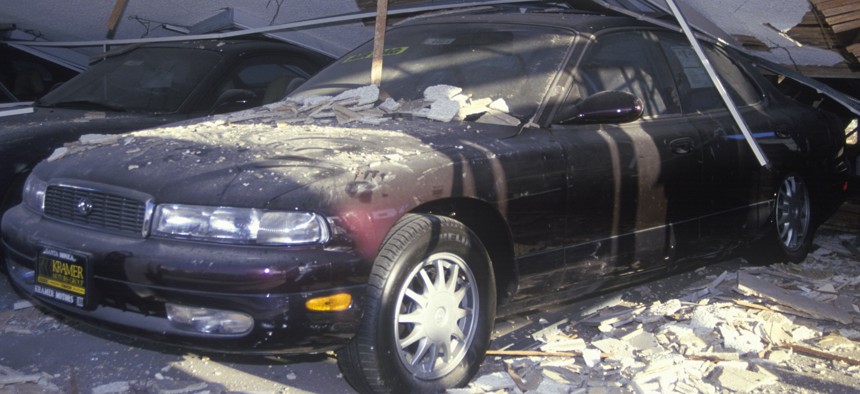Claims of an Imminent West Coast Quake Prompt Rapid-Response Reality Check

Damage from the 1994 Northridge earthquake in Los Angeles. Joseph Sohm / Shutterstock.com
Government agencies need to debunk misinformation and rumors when they surface online and spread on social media, especially when they deal with science.
Here’s another example of why you shouldn’t believe everything you read on the Internet. Yes, the West Coast will experience a major earthquake, someday. (And who knows, maybe it will strike tomorrow.)
But recent stirrings online that connect an unusual spike in carbon monoxide levels on the West Coast and an imminent major earthquake?
“Just to be blunt—this West Coast earthquake precursor rumor is nonsense.” That’s according to University of Washington seismologist and Pacific Northwest Seismic Network Director John Vidale, who on Tuesday chimed in on Facebook to debunk claims circulating online that a major quake is about to happen. (Snopes has rated the claim as Mostly False.)
For all the power the Internet has to inform, it can be a powerful tool to spread misinformation. Any public information officer or government communications professional knows this unfortunate reality all too well.
And when it comes to bombastic rumors regarding earthquake predictions, that misinformation has the potential to sow the seeds of panic if it spreads.
Lucy Jones, a seismologist with the U.S. Geological Survey who serves as a special earthquake adviser to Los Angeles Mayor Eric Garcetti, also set the record straight regarding the recent rumors.
.@caseymmartin No one has demonstrated a connection between gases and earthquakes. Lots of talk. No valid predictions
— Dr. Lucy Jones (@DrLucyJones) March 1, 2016
.@NotHenryGale I know no reason to associate any gas release with EQs. Lots of people have talked aobut it but it has never been successful.
— Dr. Lucy Jones (@DrLucyJones) March 1, 2016
As Route Fifty has previously featured, Jones is active on Twitter and regularly tries to explain earthquake science and seismic risks. And when doomsday quake predictions bubble up, she often offers a scientific reality check.
So where did the most recent rumors start? Elevated carbon monoxide readings from something called the GEOS-5 model.
A map of the surge of carbon monoxide on the West Coast from late February certainly looks threatening, right?

Some folks made a connection between those unusual readings and a looming earthquake because the “apparent spike in the monitor occurs over large fault lines, volcanoes, and above other active geological features along the US and Canadian West, it appears that activity within these features might have produced a brief if intense burp of this gas.”
And that observation began to circulate online.
The problem with that connection?
The carbon monoxide readings were incorrect and have since been explained by NASA's Global Modeling and Assimilation Office.
As Vidale wrote on Facebook:
Even if there were an anomaly in CO, it would not be an earthquake precursor. That pattern, even if it were real, would fit neither current theory nor observations of earthquakes.
But that carbon monoxide earthquake precursor certainly would make a great plot point for a Hollywood mega disaster movie—and Lucy Jones will be ready to livetweet the seismological realities from the theater.
Michael Grass is Executive Editor of Government Executive’s Route Fifty. (Photo by Joseph Sohm / Shutterstock.com)
NEXT STORY: Utah Launches New Online Map App for Transportation Projects






